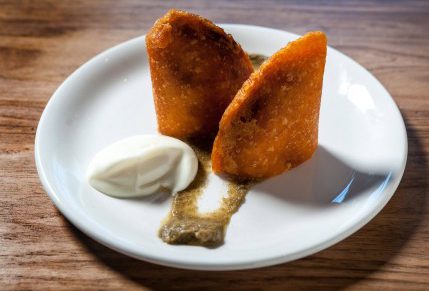Many chefs acquire a passion for food early in life. Jamie Bissonnette seemed to be born with it.
Perhaps his earliest memory is of climbing drawers to reach the kitchen countertop and feasting on whatever he could find.
“Every childhood memory I have is of food,” Bissonnette says. “I can’t remember who won my first soccer game, but I can still taste the oranges we got at halftime. I lived for flavor.”
The dishes that Bissonnette cooks today are rich, earthy and sensual. Go to one of his four Boston and New York restaurants and find suquet de mariscos, a Spanish soup featuring warm lobster and cool sea urchin, adrift on an ocean of parsnip-infused milk … or fresh mackerel marinated in Thai curry … or fried croquettes accented by pig cheeks or (perhaps) tender lemon-infused bacalao. You’re bombarded by flavors from around the globe.
However, Bissonnette’s voracious passion, his quest to eat the world, is tempered by rigorous discipline and a perfectionist’s never-ending struggle to do it right. Ask him about paella and he takes you through Spanish history and shows you how ancient Rome’s invasion and Arab conquests converged to form this one dish.
“Being a chef is about being a student,” Bissonnette says. “I’m constantly researching everything. When I meet a new thing, I want to learn all about it. I want to know every possible variation.”
While much of Bissonnette’s repertoire comes from foreign lands, that doesn’t mean he finds a traditional recipe and slavishly copies it.
“When I was young, I traveled,” Bissonnette says. “I respect authenticity, but it’s flavor that matters. Dishes are always changing – and they should. As we find new ingredients, we can play around. A Spanish dish calls for Seville oranges; why not try yuzu? That’s not sacrilege; it’s the way food should evolve.”
Perhaps this sounds like youthful arrogance – it’s not. Bissonnette is endearingly humble.
“I’m not Picasso,” he says. “I’m more like a plumber than a painter.”
Bissonnette doesn’t boss his line cooks. He listens to them.
“We cook by committee,” he says, “and that’s how it should be. A line cook has an idea for a new entree, he or she brings it to all the cooks, and we tinker with it, try to make it better. It gives us all a feeling of ownership of the restaurant and the menu.”
Bissonnette and his crew enjoy pushing the envelope. He won an award for snout-to-tail cooking (he’s received many prizes, including the Oscar of the restaurant world, the James Beard Award, in 2014), and his restaurants serve every part of the pig. When the cooks make spaghetti carbonara, they use sea urchin instead of cream. But Bissonnette never makes you eat anything you don’t like. “You like your steak well done? Well, who am I to say you can’t have it?” he says. “At the end of the day, my goal is to give my guests the best experience possible. Still, for me, the simple act of taking raw things and magically turning them into plates of wonder – that brings me joy. I love cooking. Always.”
Bissonnette AT BOTANICAL!
What
Botanical! – a three-day exploration of the way food, drink and the land intersect – features a menu curated by James Beard Award winner Jamie Bissonnette. Day One is the Passport Dinner, a sit-down, six-course meal. Day Two is Viva La Vida, a tapas-centric re-creation of Spanish nightlife. Day Three is a tasting and question-answer sessions with chefs and sommeliers.
When
April 26-28
Where
Tulsa Botanic Garden
Tickets
Go to botanicaltulsa.org or call 918-289-0330.
























